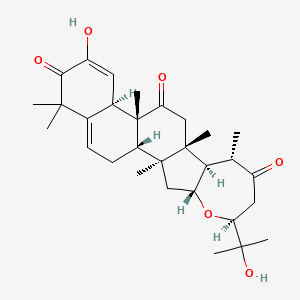| Authors | Title | Published | Journal | PubMed Link |
|---|---|---|---|---|
| Yang PQ et al. | Cucurbitacin contents in Hemsleya dolichocarpa. | 1991 | Am. J. Chin. Med. | pmid:1897490 |
| Chen X et al. | Biological activities and potential molecular targets of cucurbitacins: a focus on cancer. | 2012 | Anticancer Drugs | pmid:22561419 |
| Henrich CJ et al. | Effects of cucurbitacins on cell morphology are associated with sensitization of renal carcinoma cells to TRAIL-induced apoptosis. | 2012 | Apoptosis | pmid:21928090 |
| Tannin-Spitz T et al. | Cucurbitacin glucosides: antioxidant and free-radical scavenging activities. | 2007 | Biochem. Biophys. Res. Commun. | pmid:17942079 |
| Witkowski A et al. | Inhibition of the biosynthesis of deoxyribonucleic acid, ribonucleic acid and protein in HeLa S3 cells by cucurbitacins, glucocorticoid-like cytotoxic triterpenes. | 1984 | Biochem. Pharmacol. | pmid:6546879 |
| Witkowski A and Konopa J | Binding of the cytotoxic and antitumor triterpenes, cucurbitacins, to glucocorticoid receptors of HeLa cells. | 1981 | Biochim. Biophys. Acta | pmid:6894552 |
| Patel SK et al. | Roles of nonpolar and polar intermolecular interactions in the improvement of the drug loading capacity of PEO-b-PCL with increasing PCL content for two hydrophobic Cucurbitacin drugs. | 2009 | Biomacromolecules | pmid:19655789 |
| Patel SK et al. | Prediction of the solubility of cucurbitacin drugs in self-associating poly(ethylene oxide)-b-poly(alpha-benzyl carboxylate epsilon-caprolactone) block copolymer with different tacticities using molecular dynamics simulation. | 2010 | Biomaterials | pmid:19796808 |
| Patel SK et al. | Molecular dynamics study of the encapsulation capability of a PCL-PEO based block copolymer for hydrophobic drugs with different spatial distributions of hydrogen bond donors and acceptors. | 2010 | Biomaterials | pmid:19962756 |
| Bai M et al. | Development and validation of an LC-ESI-MS/MS method for the quantitation of hemslecin A in rhesus monkey plasma and its application in pharmacokinetics. | 2014 | Biomed. Chromatogr. | pmid:24132644 |
| Bartalis J and Halaweish FT | In vitro and QSAR studies of cucurbitacins on HepG2 and HSC-T6 liver cell lines. | 2011 | Bioorg. Med. Chem. | pmid:21459003 |
| Ramalhete C et al. | New potent P-glycoprotein modulators with the cucurbitane scaffold and their synergistic interaction with doxorubicin on resistant cancer cells. | 2009 | Bioorg. Med. Chem. | pmid:19733087 |
| Guo RH et al. | Synthesis of hemslecin A derivatives: a new class of hepatitis B virus inhibitors. | 2013 | Bioorg. Med. Chem. Lett. | pmid:23385212 |
| Chen CH et al. | Identification of cucurbitacins and assembly of a draft genome for Aquilaria agallocha. | 2014 | BMC Genomics | pmid:25005802 |
| Kuo TC et al. | The effect of red light and far-red light conditions on secondary metabolism in agarwood. | 2015 | BMC Plant Biol. | pmid:26067652 |
| Boykin C et al. | Cucurbitacin IIa: a novel class of anti-cancer drug inducing non-reversible actin aggregation and inhibiting survivin independent of JAK2/STAT3 phosphorylation. | 2011 | Br. J. Cancer | pmid:21304528 |
| Ren S et al. | Anti-proliferative effect of 23,24-dihydrocucurbitacin F on human prostate cancer cells through induction of actin aggregation and cofilin-actin rod formation. | 2012 | Cancer Chemother. Pharmacol. | pmid:22814677 |
| Jayaprakasam B et al. | Anticancer and antiinflammatory activities of cucurbitacins from Cucurbita andreana. | 2003 | Cancer Lett. | pmid:12445672 |
| GALLILY R et al. | Further studies on the antitumor effect of cucurbitacins. | 1962 | Cancer Res. | pmid:13946249 |
| Gabrielsen M et al. | Cucurbitacin covalent bonding to cysteine thiols: the filamentous-actin severing protein Cofilin1 as an exemplary target. | 2013 | Cell Commun. Signal | pmid:23945128 |
Cucurbitacin S
Cucurbitacin s is a lipid of Sterol Lipids (ST) class. The involved functions are known as establishment and maintenance of localization and nitric oxide biosynthetic process.
Cross Reference
Introduction
To understand associated biological information of Cucurbitacin S, we collected biological information of abnormalities, associated pathways, cellular/molecular locations, biological functions, related genes/proteins, lipids and common seen animal/experimental models with organized paragraphs from literatures.
What diseases are associated with Cucurbitacin S?
There are no associated biomedical information in the current reference collection.
No disease MeSH terms mapped to the current reference collection.
PubChem Associated disorders and diseases
What pathways are associated with Cucurbitacin S
There are no associated biomedical information in the current reference collection.
PubChem Biomolecular Interactions and Pathways
Link to PubChem Biomolecular Interactions and PathwaysWhat cellular locations are associated with Cucurbitacin S?
There are no associated biomedical information in the current reference collection.
What functions are associated with Cucurbitacin S?
Related references are published most in these journals:
| Function | Cross reference | Weighted score | Related literatures |
|---|
What lipids are associated with Cucurbitacin S?
There are no associated biomedical information in the current reference collection.
What genes are associated with Cucurbitacin S?
There are no associated biomedical information in the current reference collection.
What common seen animal models are associated with Cucurbitacin S?
There are no associated biomedical information in the current reference collection.
